PSYC2900: Wk 9-12
1/83
There's no tags or description
Looks like no tags are added yet.
Name | Mastery | Learn | Test | Matching | Spaced |
|---|
No study sessions yet.
84 Terms
Conformity bias
Tendency for social psychology to treat group influence as a one-way process in which individuals or minorities always conform to majorities. This was a criticism of Sherif and Asch’s study which led to minority influence studies.
Minority influence: Asch paradigm
Participants in Asch’s studies realise that the majority of people would pick the correct comparison line meaning that when participants get influenced by the other confederates they are actually just being influenced by a minority of six people who disagree with the majority opinion.
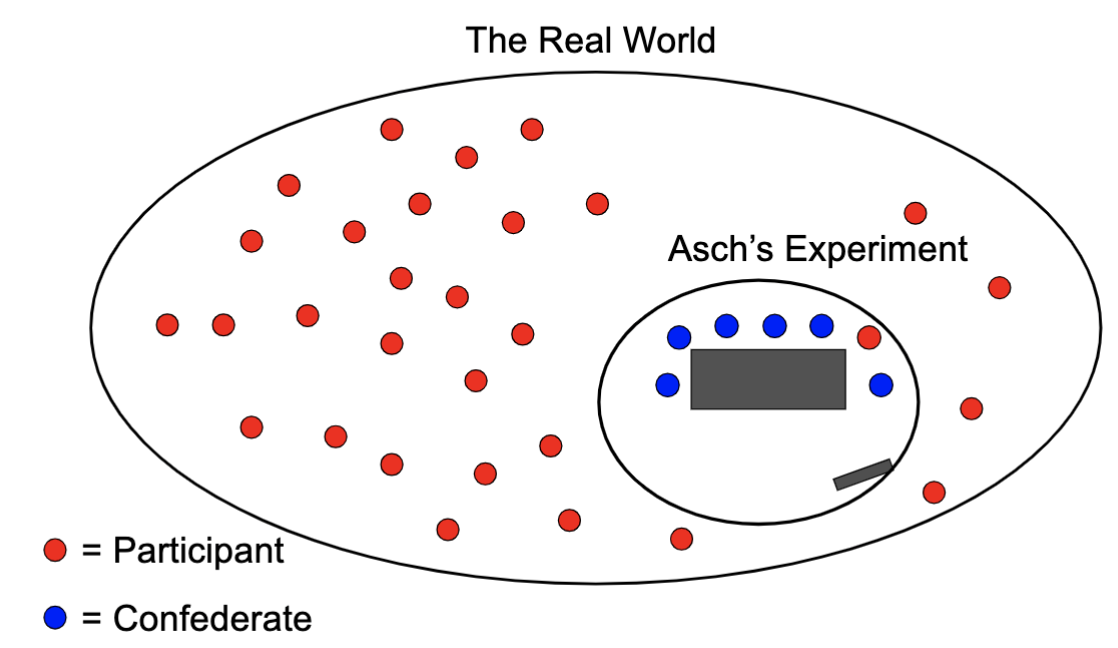
Three social influence modalities
Normalisation = both groups compromise on their position and meet half-way
Conformity = minority adopts the majority’s position
Innovation = majority adopts the minority position (Asch’s study)
4 key aspects of the behavioural style of minority groups (Moscovici, 1976)
Consistency = minority proposes clear position on an issue and sticks to it
Investment = minority is seen to have made personal/material sacrifices for position
Autonomy = minority seen to be acting out of principle not ulterior motives
Flexibility = minority seen as flexible and realistic
The role of consistency in minority influence
Consistent minorities draw attention as ppl who provide an alternative and coherent perspective which makes majorities doubt their own perspective. Two forms of consistency:
Diachronic consistency = intra-individual consistency over time
Synchronic consistency = inter-individual consistency i.e. stable traits at one time
Blue colour minority influence study: Phase I (Moscovici, Lage, and Naffrechoux, 1969)
Participants were told they passed a colour blindness test → put into groups of 6 → shown slides that were clearly blue but some where bright vs dimly → participants judged colour aloud. Conditions: control = no confederates; inconsistent = two confederates answered green on 2/3rds of trials; consistent = two confederates answered green on all trials.
Blue colour minority influence study: Phase I results (Moscovici, Lage, and Naffrechoux, 1969)
The percentage of incorrect responses in each condition:
Control = <0.5%
Inconsistent = 11%
Consistent = 83%
Demonstrates the importance of consistency in minority influence
Blue colour minority influence study: Phase II and results (Moscovici, Lage, and Naffrechoux, 1969)
Participants took part in a “separate” experiment on colour vision → shown series of disks varied from blue to green gradient → asked to privatey categorise disk as either blue or green. Results: participants who had been in the consistent condition described more blue-green disks as green and fewer as blue than participants in the control
Conversion theory
Categorises differences between majority and minority influence:
Majority operates via informational/normative influence vs minority operates via a validation process
Majority doesn’t require much cognitive elaboration vs minority requires cognitive elaboration/restructuring
Majority produces public compliance and superficial private acceptance vs minority produces long-lasting private acceptance (conversion effect)
Conversion effect
When something produces a long-lasting private acceptance.
Minority influence blue afterimage study (Moscovici & Personnaz, 1980)
Participants were in pairs (participant + confederate) and shown blue slides → rated colour and colour of afterimage 9-point (1 yellow, 5 blue, 9 purple). Conditions: control = no additional information; majority source = told that 18.2% of previous participants said blue but 81.8% said green; minority source = told that 81.8% previous participants said blue and 18.2% said green.
Four phases of minority influence blue afterimage study (Moscovici & Personnaz, 1980)
Phase 1 = participants privately rated colour of slide/afterimage to get a baseline
Phase 2 = participants publicly rate slide in presence of a confederate who always answered first and said green (social influence phase)
Phase 3 = participants privately rated slide/afterimage in presence of confederate
Phase 4 = participants privately rated the slide slide/afterimage in the absence of the confederate
Results of minority influence blue afterimage study (Moscovici & Personnaz, 1980)
Control condition = rated afterimage as more yellow as phases progressed
Majority condition = rated afterimage as more yellow as phases progressed
Minority condition = rated afterimage as more purple as phases progressed
Demonstrates that the minority influence can make people literally see the world like the minority bc the study doesn’t actually influence the afterimage participants see
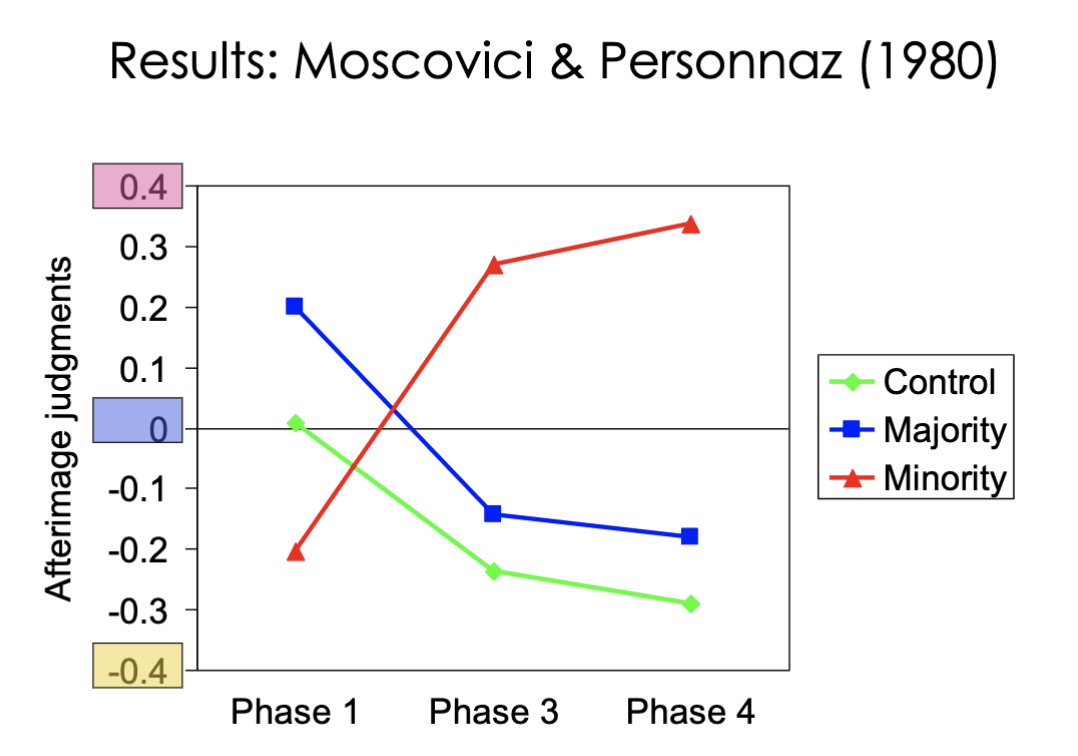
Conclusions of minority influence studies
Minority influence led to profound private shirt in peoples perceptual systems (conversion effect) AND the afterimage colours were different from the green colour called out by confederates so this wasn’t just participants mimicking confederates responses. Majorities influence minorities (Sherif, Asch) and minorities influence majorities (Moscovici)
Minority influence and social change
If there was no minority influence there would be no social change (if it was only majority everyone would just agree on everything). When we focus on the majority then only prejudices are reduced however when we focus on the minority this leads to collective social action
Prejudice
A preconceived, often negative, attitude or evaluation of person or group based on their perceived social group membership rather than on individual characteristics. Often based on faulty/inflexible generalisations that may be direction towards a group or individual member of the group.
Discrimination
The behavioural expression of prejudice towards a person or group e.g. sexist and racist behaviours.
Reverse discrimination
Practice of publicly being in favour of a minority group in order to deflect accusations of prejudice and discrimination against that group. This can include tokenism which is publicly making small concessions for the same purpose.
Social mobility belief system
Belief that intergroup boundaries are permeable thus it is possible for someone to pass from a lower-status into a higher-status group to improve social identity.
Social change belief system
Belief that intergroup boundaries are impermeable therefore a lower-status individual can improve social identity only by challenging the legitimacy of the higher-status groups position
Three dimensions of prejudice
Cognitive (stereotype) = beliefs about characteristics of groups of people
Affective or emotional (prejudice) = hostile or negative attitude towards a group of people solely based on group membership with emphasis on emotional dimension
Conative/behavioural (discrimination) = behaviour (positive or negative) directed toward a social group or its members due to group membership
Frustration-aggression hypothesis
An individual-based explanation of prejudice that suggests all frustration leads to aggression and all aggression comes from frustrations. Used to explain prejudice and intergroup aggression. Relates to displacement were aggression cannot be expressed against source of frustration then it is redirected towards another target i.e. a scapegoat (e.g. out-group)
Problems with the frustration-aggression explanation
Difficult to predict which out-group will be the target of aggression and research (Bandura & Berkowitz) has found that frustration is neither necessary no sufficient for aggression to occur.
Personality perspectives on prejudice
Theorises that some aspects of personality are more likely to foster prejudicial attitudes including authoritarian personality = individual attitudes to different out-groups and minorities are strongly correlated.
Group-based approach to prejudice
Suggests that we cannot just have individual explanations for prejudice which is a group theory and that there are additional intergroup factors that need to be considered.
Social identity and prejudice reduction
Self-categorisation theory argues that the self is hierarchically organised: individual/personal self → social self → subgroup identity/self → superordinate identity/self
De-categorisation
The perception of both in-group and out-group members as belonging to one superordinate category and think of ourselves and others as individuals to prevent categorisation. Not realistic and doesn’t help enact change. Low subgroups and low superordinate.
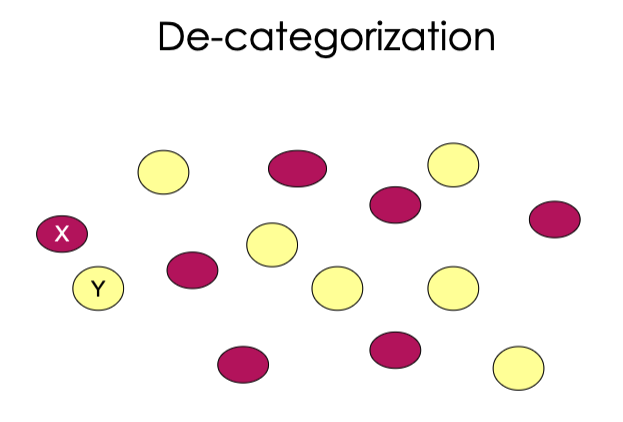
Categorisation
Categorisation often contributes to intergroup differentiation i.e. them vs us which leads to category-based judgements e.g. negative stereotypes of all out-group members. Categorisation → inaccurate perception of individuals → prejudice
Dual categorisation
High subgroups and high superordinate i.e. distinct subgroups but a very distinct superordinate concept = individuals simultaneously perceive people through subgroups e.g. age AND as a superordinate identity e.g. human. However, its hard for us to maintain multiple salient identities. Politicians often engage in dual categorisation by referring to the whole group as we and trying find superordinate issues/goals/themes that can tie different sub-groups together
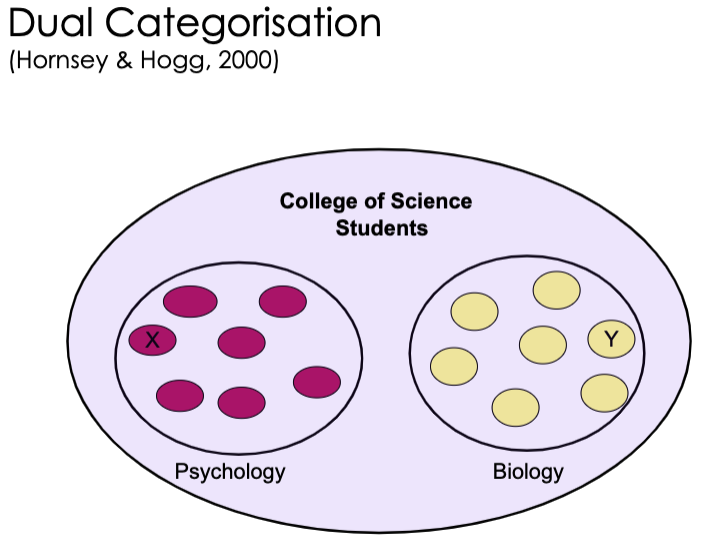
Sub-categorisation
Mutual intergroup differentiation which retains the positive subgroup distinctiveness but in a cooperative context i.e. weak superordinate. Not always realistic because there is often conflict between these subgroups that the model doesn’t address
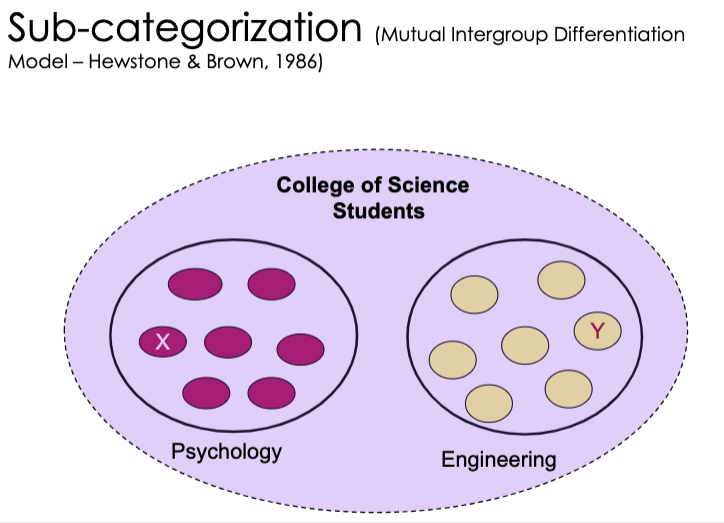
How does each categorisation component work together
Re-categorisation = low subgroups and high superordinate
De-categorisation = low subgroups and low superordinate
Sub-categorisation = high subgroups and low superordinate
Dual-categorisation = high subgroups and high superordinate
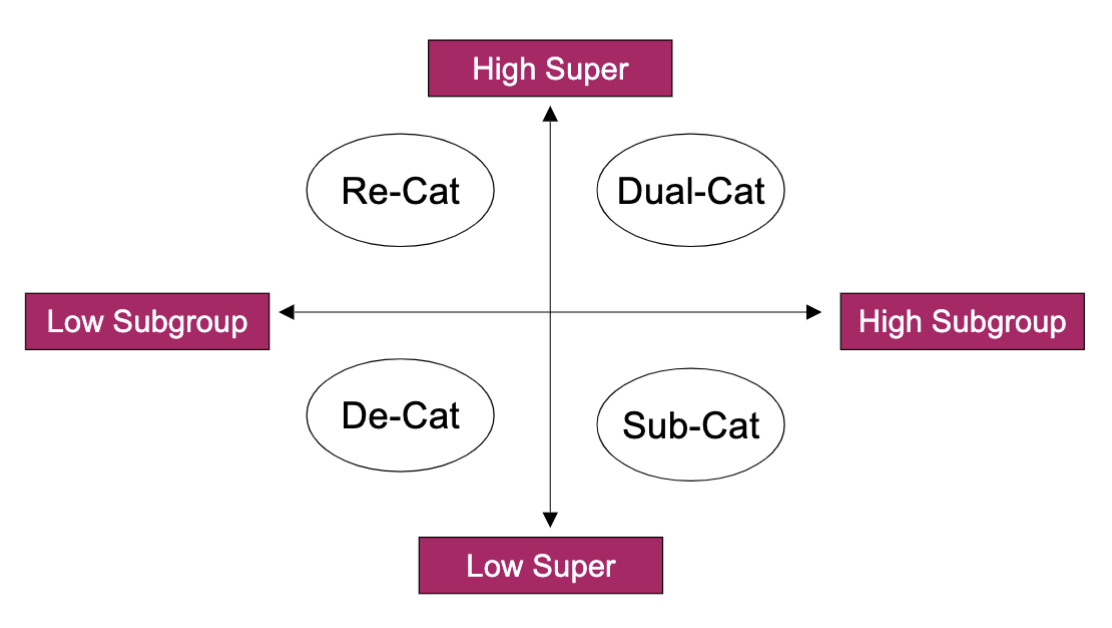
Re-categorisation
Maintains a common in-group identity go reduce prejudice and perceive both in-group and out-group members as belonging to one superordinate category. Doesn’t always represent everyone equally with not everyone being captured by that broad identity.
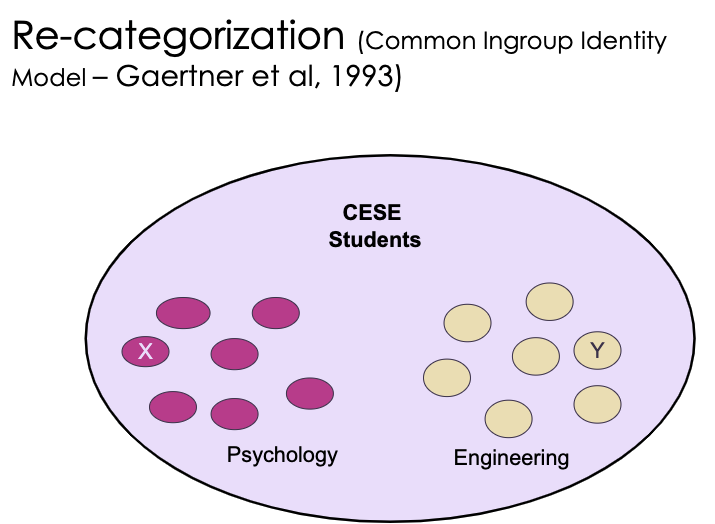
Prejudice reduction as social change
Micro-level prejudice reduction strategies may be ineffective as prejudice has widespread social implications therefore we need political social action from government authorities or individuals/social movement. Therefore we need to facilitate conditions where social action can take place which involves changing intergroup relations (since intergroup inequalities create the basis in social reality)
Social change
Can be incidental change (gradual change in behaviour due to technology) or intentional change (protests)
Psychology of collective action
Shifting identity from me to we which produces a social identity → social change
It’s
myour problem which produces a shared sense of injustice → social changeAction → change i.e. if we all do something thens something will change
Social protest for sympathisers to social movements
Become part of a mobilisation potential → becoming a target of mobilisation attempts → developing a motivation to participate → overcoming barriers to participation
Types of influence and social change
Focus on majority → prejudice reduction = focus on improving attitudes of the majority groups towards relevant minority groups
Focus on minority → collective action = disadvantaged groups rise up to challenge the majority and engage in social action
Focus on political solidarity = majority acts in solidarity with the minority
Political solidarity
Arises in response to injustice/oppression where people commit to join with others to challenge a perceived injustice. Unity based on shared cause rather than shared history of oppression (i.e. minority groups) because sharing common history of oppression is not always sufficient for solidarity bc each group needs to share a vision of the future regardless of whether each individual actually experienced the relevant history. Political solidarity is inherently oppositional i.e. opposes injustice and tyranny.
Three dualisms of social change (Dualism 1)
Social change vs status quo = status quo is the absence of social change however social change does not equal the absence of status quo. Social change is something we need to enact and create i.e. we need more interaction
Three dualisms of social change (Dualism 2)
Conflict vs cooperation = conflict and cooperation are part of the same social change process with conflict involving active protest and challenges to existing power relations while cooperation involves mobilising widespread support for ones cause. Conflict and cooperation can also be used to maintain the status quo i.e. conflict can involve marginalising one’s opponents while cooperation involves maintaining/enhancing one’s support base.
Three dualisms of social change (Dualism 3)
Bipolar intergroup relations i.e. high vs low status, dominant vs subordinate, privileged vs disadvantaged, etc = considers if there are more than one story
Tripolar intergroup power relations
Authority directly affects the majority with affects the minority with affects the authority (and all of them affect each other). Status quo is more likely when authority and majority are closely connected/siding while social change is more closely connected/siding with the minority and majority.
Breakdown of political solidarity concepts
Political = challenging existing power relations in line with shared cause + challenge to legitimate authority
Solidarity = common cause i.e. majority embracing the minority cause as its own. Shared orientation to the status quo (social change is needed). Unity in diversity i.e. recognition of (subgroup) differences but also able to work together.
Leadership intersecting with social change
Significant advances that demonstrates an intersection between leadership and social change with social change being a fundamentally process of mobilisation while leadership is fundamentally a group/intergroup process. Process:
Leaders lead in multi-audience contexts with leaders mobilising but also creating intergroup divides
Leadership is a contest for influence with multiple leaders seeking to mobilise ‘us’
Social identities are fluid and future orientated with leaders aligning with who we are becoming to lead to more effective change
Gender inequality
Gender pay gap shows that women earn 78 cents for every $1 a man earns ($28,425 yearly difference). Data on the pay gap:
WGEA (base salary, bonuses, overtime, full-time, part-time and casual) = 22.8% gender pay gap
ABS data (full time and base salary only) = 13% gender pay gap
This gender pay gap increases with higher salaries = highest paid man earn at least $162,000 less than highest paid women. With only 21.9% of women
Global lowest gender gap index 2024 top ten
Iceland
Finland
Norway
New Zealand
Sweden
Nicaragua
Germany
Namibia
Ireland
Spain
Global gender gap report
Suggests that the global gender gap is 68.5% closed with the gap narrowing however the collective rate of progress has slowed down and will take 134 years to reach full close.
Largest areas with gender gaps
Economic participation and opportunity (60-5%), political empowerment (22.5%), STEM (29.4% in entry and only 12.4% in senior positions), and non-STEM (55.6% in entry and only 27.5% in senior)
Cause of persistent gender inequality
Bias discrimination in job selection/promotion with 40% of gender inequality resulting directly from gender based discrimination at work (25% career interruptions, 17% low-paid occupation, 7% unpaid care). Gender roles and leadership stereotypes, benevolent/hostile sexism, and the glass cliff.
Psychology of gender inequality
Focus on origins, existence and persistence on inequality rather than on achieving equality however this is not sufficient to understand how social change can take place. We need to understand whether bias → inequality or inequality → bias because if it is the latter we need to address inequality first. The status quo sees women’s as victims, mens as bystanders and perpetrators rather than agents of change
Glass ceiling
An invisible barrier that prevents women and minorities in general from attaining top leadership positions
Role congruity theory
Mainly applied to the gender gap in leadership where since social stereotypes of women are inconsistent with peoples schemas of effective leadership then women are overgeneralised and evaluated as poor leaders
Stereotype threat
Feeling that we will be judged and treated in terms of negative stereotypes of our groups and that we will inadvertently confirm these stereotypes through our behaviour
Glass cliff
The tendency for women, rather than men, to be given precarious leadership positions associated with a high probability of failure and criticism. Setting women up for failure
Shift in thinking towards gender inequality
Emerging work showing men and women engaging in collective action with men being more likely to take part in initiatives when they have psychological standing. Engaging men is increasingly the focus of interventions however there is concerns of token involvement i.e. limited focus on actual change (requires a feminist perspective rather than dependency-orientated allyship.
We for She movement
A political solidarity approach to understanding gender equality where men and women are agents/champions of change that have a common cause (achieving equality), reject status quo (inequality as illegitimate), willing to act collectively to achieve change (agents) and willing to lead change (champions). Considers different set of identities, roles, and expectations for all groups with leadership/social influence as key parts of mobilisation process. Women still largely lead the change towards gender equality.
She-change approach to gender equality
Women are disadvantaged and targets of gender inequality and gender-based discrimination therefore women are primarily responsible for making change happens as targets of change interventions, change agents, and change leaders. Critiques = should sisters be doing it by themselves
She-change → We-change
She-change = addressing inequality, their problem, not a problem, they’re the problem, and symbolic change via token allyship
We-change = creating change for gender equality, our problem, and systemic change via transformative allyship
Redefining the problem includes bidirectional concepts such as women’s issue vs common cause, male vs female leaders, and male vs female allies
Message framing for gender equality
This involves manipulating the frame of the issue i.e. government responsibility, mens responsibility, women’s/mothers issue, mens/fathers issue and a parents issue. When we frame a message from mens responsibility and as a parents issue, men feel more mobilized and have higher collective action intentions. Women feel mobilised across message framing conditions, it is men we need to focus on to improve collective action.
Leader of the message for gender equality
Measured the impact of when different genders are the leader of the message about gender equality. Found that when its a male leader framing it as a women’s issue it leads to lower collective action for men than a female leader framing it as a women’s issue however a make leader framing it as a common cause issues leads to the most collective action intention for men. Similar things can be seen for male vs female allies which shows overall that common cause messages are important and that male allies are important for men to increase collective action intention.
Summary from studies on gender equality and intention to engage in collective action
Widespread mobilization for change is more likely when gender equality is seen as a shared/collective problem. Male feminist leaders and allies are important as their involvement signals gender equality as our problem and enhances the view of the female leader as one of us. Allyship based on systemic (vs symbolic) action is essential as it signals that we are committed to achieving change.
Prosocial behaviour
Refers to acts positively valued by society including helping and altruistic behaviour. Difficult to explain with traditional theories because it’s generally assumed that behaviour is egoistic i.e. everything we do is ultimately done to benefit ourselves. Prosocial behaviour is unusual because it seem to be independent of reinforcement and reflects optimistic/positive view of human beings.
Helping vs altruism
Helping = acts that intentionally benefit someone else but sometimes be with expectation of personal gain e.g. public contribution to charity
Altruism = special form of helping that shows concern for fellow human beings and is performed without expectation of personal gain e.g. buying groceries for homeless person
The Bystander-Calculus model: Empathy and arousal
Perspective taking (cognition-based) “I see your pain” → empathy i.e the ability to feel another persons experiences and identifying emotions, thoughts and attitudes “I feel your pain” → perspective taking, increased empathy and increased helping behaviour. This links to why people are often more likely to shown prosocial helping behaviour to people that are in your in-group because you experince more empathy.
The Bystander-Calculus model: Stages
Physiological arousal → labelling the arousal → evaluating the consequences. This model suggests that altruism is motivated by self-interest. Suggests that an act is truly altruistic if ppl help when they are no longer troubled by observing the suffering of another person. Research agrees that true altruism can only occur when the potential helper can easily not help e.g. quietly slip away. This model suggests that helping/prosocial behaviour is innate/biological.
Learning to be helpful model
Suggests that prosocial behaviour is learned and not innate. Prosocial behaviour can be taught by giving instructions (telling a child to be helpful), using reinforcement (behaviour that is rewarded is more likely to re-occur) and modelling (watching someone else help). Found that positive reinforcement had the most effect willingness to behave generously followed by no consequences and then punishment. Related to social learning theory.
Modelling and helping behaviours
Model showing us how to perform helpful acts increases our confidence in being able to give help and give us information about the consequences of helping others. A study on modelling found that motorists exposed to the pro-social model were over 50% more likely to help than those without the model. Other studies found that observing ppl who were pleased with helping i.e. positive consequences were most likely to help.
The Bystander Effect
People are less likely to help in an emergency when they are with others than when they are alone i.e. the greater no. of bystanders = less likely it is that anyone will help. Example: Kitty Genovese murder that was witnessed by 38 people. Being aware of the bystander effect can help reduce it.
Latane and Darley’s cognitive model (The Bystander Effect)
Attend to what is happening → define event as an emergency → assume responsibility → decide what can be done = give help. An emergency situation is defined as one that can involve danger to person or property, is an unusual event, can differ widely in nature, is not foreseen, and requires instant action. This model is more about emergency’s not general prosocial behaviour.
Experiment 1 (Where there’s smoke there’s fire): The Bystander Effect
Partcipants were either alone, with two unknown others, or two confederates who ignored the smoke. Smoke began filling the room and those alone most likely reported the smoke (75%), two unknown others (38% reported), and two passive confederates (10%). This demonsrates that we are using other people to inform whether we take action.
Experiment 2 (Lady in distress): The Bystander Effect
Male particpants heard women struggling and were led to believe that maybe a cabinet had fallen on her (she yelled in pain). Particiants were either alone (70% helped), in pairs (40%), or with a passive confederate (7%). Showed that having a person involved still producded similair result to smoke study.
Experiment 3 (He’s having a fit): The Bystander Effect
Participants could communicate to eachother via microphones in seperate cubicles. Believed groups consisted of either two people (self + victim of epileptic fit), four people (self, two others, victim), or six people (self, 4 others, victim). Alone helped 85% of time, two or more 62% of time, and four or more helped 31% of the time. Demonsrated the diffusion of repsonsibility + showed that after 6 minutes elapsed, percetages rose to 100, 81 and 62 respectively.
Bystander apathy
The act of not helping a victim that is explained by the bystander effect where we attribute the lack of helping of the number of bystanders present.
Key situational factors and social processes for bystander apathy
Situational factors = is the bystander aware that others are present, can others seen/heard and how are they reacting and can these others monitor the behaviour of the victim.
Social processes = diffusion of responsibility, audience inhibition and fear of social blunders and social influence
Real life example of the Bystander Effect: Workplace sexual harassment
41% of people witnessed/heard abt sexual harassment of another person at work, 35% took action to prevent/reduce harm (men 36%, women 34%) and 61% of ppl who took action said the harassment stopped as a result.
Reasons for not taking action after witnessing sexual harassment
Some of the main reasons are linked to the Bystander Effect including I didn’t want to get involved, I didn’t know what to do, I didn’t think it was serious enough to intervene, I was worried about the negative impact of taking action on me, and I didn’t think it was my responsibility.
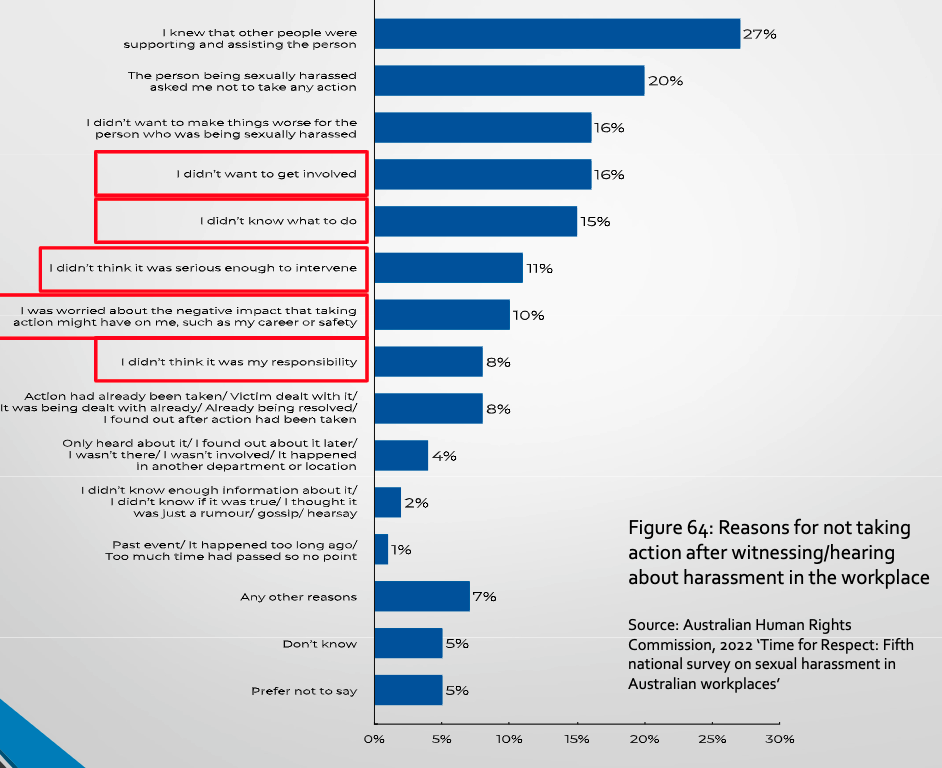
Workplace sexual harassment: Latane and Darley’s cognitive model
Failure to define event as emergency = “Did not think it was serious enough to intervene”
Failure to assume responsibility = “Did not want to get involved and did not think it was my responsibility”
Failure to decide what can be done = “Did not know what to do”
Workplace sexual harassment: The Bystander-Calculus model
Shows that when people evaluate the consequences instead of evaluating the consequences in relation to the victim they evaluate it for themselves “I was worried about the negative impact that taking action might have on me, such as my career or safety”.
Personal attributes: Personal characteristics and prosocial behaviour
Personal attributes that predict prosocial behaviour include being agreeable, heavier physical appearance, ability to forgive, and secure attachment style. Acting prosocially predicted by a combination of personality, the situation, and the person requiring help
Mood states: Personal characteristics and prosocial behaviour
Good moods = can be induced by letting participants know if they have succeeded or failed at a tasks → found that those who believed they had succeeded where more likely to contribute to a school fundraising drive
Bad moods = create an internal focus which reduces concern for others wellbeing → anger can increase prosocial behaviour that resolves around combatting injustice
Other factors: Personal characteristics and prosocial behaviour
Size of hometown, competence (have skills, will help), leaders and followers (leaders do not experience the same amount of diffusion of responsibility), and gender differences
Prior commitment: Encouraging prosocial behaviour
Non-prosocial behaviour is very common e.g. 66% cheat at school, 40% driven while drunk, etc. so how dowe encouage prosocial behaviour. If we give people a prior commitment to being repsonsible people are more likely to engage in prosocial behaviour e.g. asking people to watch their luggage means they’re more likely to intervene if someone else trys to steal it.
Norms: Encouraging prosocial behaviour
Norms are standards of actions that describe/prescribe what is expected, normal and proper. We help each other out because it is normative and there are social rewards for behaving in line with the norms/sanctions for violating them (e.g. social disapproval or legal penalties). Two main norms for prosocial behaviour include reciprocity and social responsibility norm.
Motives: Encouraging prosocial behaviour
Four motives = egoism (to benefit yourself), altruism (to benefit others), collectivism (contirbute to welfare of social group/in-group), and principilism (follow moral principles)